* (restored)
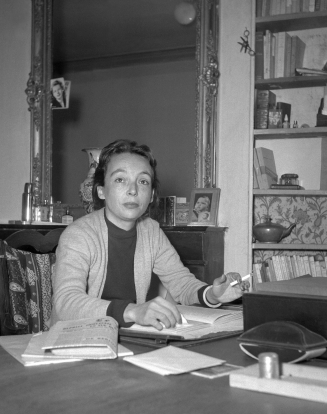
‘In the 1970 first published in English edition of Destroy, She Said Marguerite Duras has added a couple of paragraphs at the back entitled ‘notes for performance’ indicating the novel can be used as a play. In these notes she makes suggestions about characters physical appearances, inflections, movement styles etc. Towards the end she makes this interesting point: “No one actually ‘cries out’, even when the word is used: it indicates an inner reaction only.”
‘This is an excellent summation of Destroy, She Said, a novel rife with pent-up frustrations, and the interpersonal attack human creates will make on another human creature they perceive for whatever reason, may be weaker than themselves. It’s a wholly political novel, written in 1969 under the pro economic modernist and contemporary industrialist presidency of Georges Pompidou. In fact when one of the two main characters describes herself and her two contemporaries as German Jews, she is referring to a famous anti-nationalist student slogan of 1968.
‘However, when Pompidou tried to appropriate the novel as a symbol of the destructiveness of modern youth, he made an error. The ‘Capitalist destruction’ Alissa is bent on is not the destruction of buildings and institutions, but the annihilation of ‘civilized’ egoism. Marguerite Duras herself said “Destroy… annuls the others” meaning that this is the most radically revolutionary of Duras’ novels providing a kind of crescendo for a lifetime of work, in terms of her political points. Destroy She Said may not be the most exquisitely beautiful of her works (there is an ocean of exquisite beauty in Marguerite Duras, so which work can be seen as the apex of all that is far beyond me to judge) but it is the most aggressive and forthright that I have read. The way the three main characters descend upon Elizabeth Alione is ruthless in the unapologetic self-serving nature. Characters are often cries in Duras’ novels, and always haunted by the unsayable, but these three are unencumbered by their own philosophical positions; rather they are inquiring as they conquer.
‘Barbra Bray (translator) writes in the introduction to the English translation, that Duras’ characters have always managed somehow to dissolve barriers between them despite overwhelming gulfs in recognition of person hood. In Destroy, She Said this is no longer a tendency but a fully realized notion. In Destroy, She Said, Alissa, Max Thor and Stein are almost interchangeable. Their relationships and identities are always interchanging, subtly shifting and merging and admit none of the men and women’s usual possessiveness and competition. Even Alissa and her antagonist Elizabeth (or should I say her ‘prey’) can meld into one in certain scenes in the novel.
‘In many ways Elizabeth represents many Duras heroines prior to this novel: middle-aged, bourgeois, elegant, attractive, whose life is all emotion. Through the eyes of the three young people she emerges as weak and in need of conversion, but in typical Duras style, we see her differently to those around her. To quote Bray again, “The character, in spite of having now been marked down for demolition, is much the same; it is the author who has moved on.”
‘It is this inter subjectivity in the novel, especially revealed through the use of ‘he’ and ‘she’, that keeps the book far from any form of realism. There is no need within the novel to puzzle out the relationship between Alissa, Max Thor and Stein despite their constant interwoven narrative, declarations of love, and mutual intentions. Prior to this, Duras’ concepts of love were more or less conventional, always straining toward an impossible fulfillment. In Destroy, She Said, the battles between men and women are abandoned. Stein and Max Thor both love Alissa without jealousy and Stein counsels Alissa in not reacting to Maz Thors feelings for Elizabeth Alione. This counseling is a direct reference to Bakunin and the anarchist notions of “not suffering”. “The psychological implications of all this are not even glanced at. They are not the point. The book presents a pattern rather than relates a narrative,” states Bray in the introduction.
‘It is Duras’ habit of seeing what she writes and writing what she sees that moves the structure to its natural powerful reduction. The novel Destroy She Said owes as much to the image as to the word. When the book is made into the film, the images becomes beautifully dependent on the word. The result is something condensed as always with Duras, physical ambiance kept to a minimum. None of the other hotel gusts are ever seen. The Tennis is only ever heard. In the dialogue there is no analysis and no suppositions about what anyone things or feels. Characters are oblique as necessary to give meaning, not representations of real people. The result is a radical novel, as difficult to grasp as it is enticing to read. One gets the feeling of holding a subversive text, though the revolution is never within one’s grasp. In this way, Georges Pompidou was accurate in that it was a novel with timely tale to tell, but perhaps not as neatly prescribed as he hoped. Perhaps, also far more radical than he could be comfortable with.’ — Lisa Thatcher
___
Further
Marguerite Duras Site
‘Destroy, She Said’ @ goodreads
Discussion: May selection: Marguerite Duras’ Destroy, She Said
The Novelist as Filmmaker: Marguerite Duras’ “Destroy, She Said”
Chamber Utopia – A Commune Banished In Advance – A Different Humanity (Real Humanism vs. Vanity)
In a play-like novel which was later the same year turned into a haunting film
Erosion by Desire: Marguerite Duras’ Self-Adaptations
A Review of She Said Destroy, by Nadia Bulkin
Awe, reverence, respect, self-respect, shamefastness, sense of honor, sobriety, moderation, regard for others, regard for the helpless, compassion, shyness, coyness, scandal, dignity, majesty, Majesty.
OUT OF TIME
Buy ‘Destroy, She Said’
___
The film
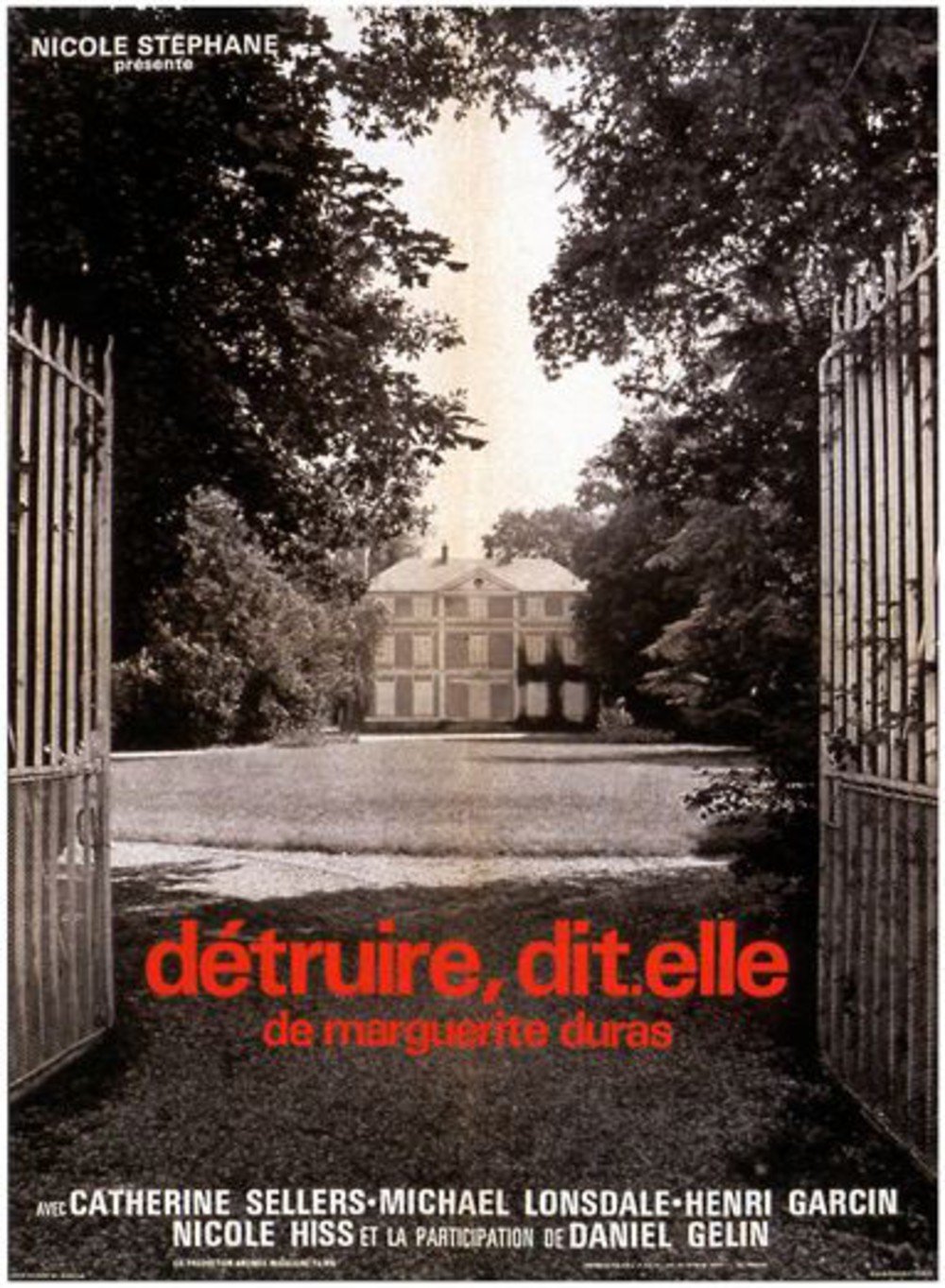
‘Translating an enormously dense short novel to the screen is no easy feat, even if it’s your own novel. Especially when the very architecture of text on the page and the limitations of the written word are foundational to the story’s ultimate purpose. In the novel you get a sense of some metaphysical fusion of the three lead characters during their interrogation of Elisabeth, which is super difficult to replicate in film. The subtle influence of the cinematic language in sequences that hint at cuts and a flow of editing are made overt on the screen. But even this is something special. To see the architecture of word structure replaced with the architecture of characters within a hotel. Leaning against walls, caught between mirrors and perspective, light and shadow. The camera is ever shifting its perspective without losing its targets. What it loses by including visual reference it gains from knowledge of cinema’s time capturing abilities. The use of long static takes is beautiful. The framing is beautiful. The mirror shot!! The flow of their interrogations are uncomfortably clear. The precision of their words maybe seem more obvious. The card game scene is frighteningas hell. I don’t think it exceeded the magnificent (and perfect) text, but what Duras created on film is still mesmerizing.’ — Jacob
Excerpt
Excerpt
the entirety
____
Extra
Marguerite DURAS on the set of “Détruire dit-elle” -1969
____
Manuscript page
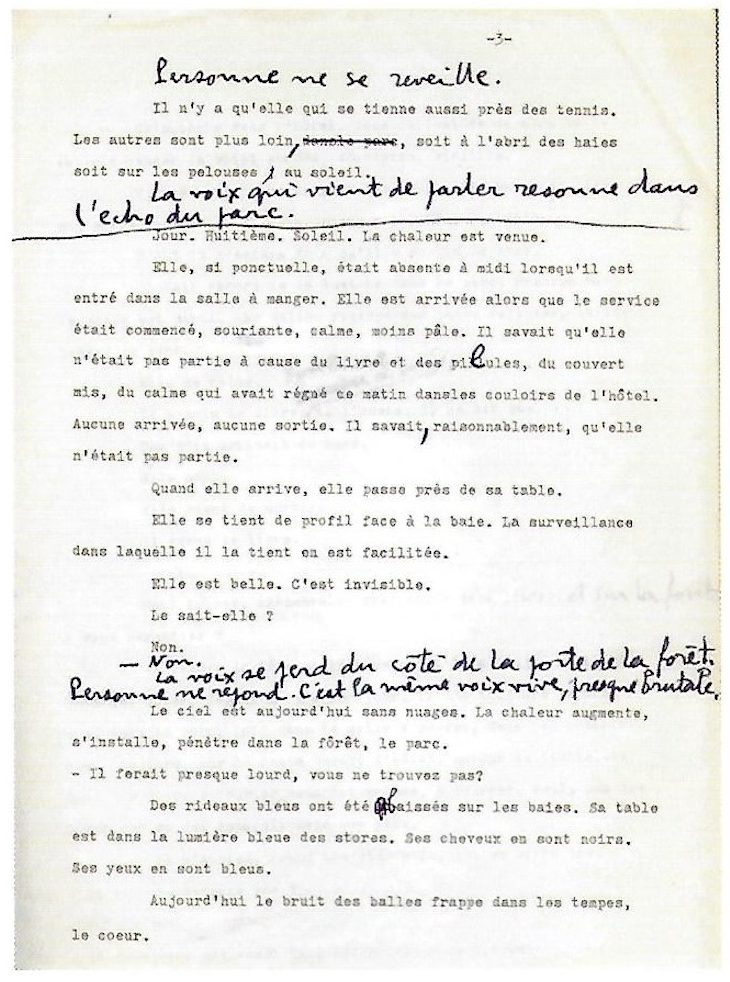
____
Interview
from Seven Stories
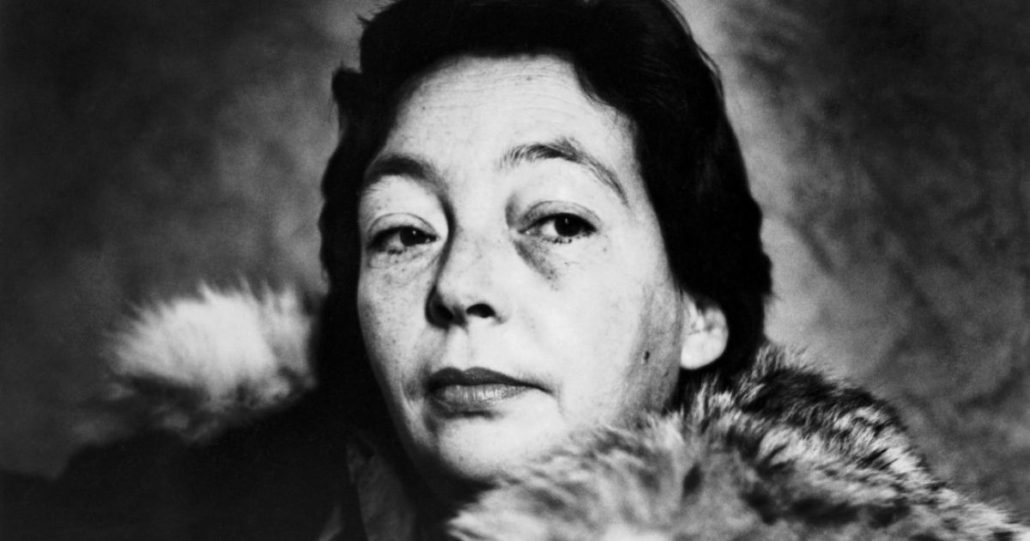
Question: It seems you want more and more to give successive forms to each of the things—let’s not use the word “stories”—that you write… for instance, The Square, which had several versions, or La Musica, which also had several forms, or L’Amante anglaise. This corresponds to…
Answer: To the desire that I always have to tear what has gone before to pieces. Destroy, She Said is a fragmented book from the novelistic point of view. I don’t think there are any sentences in it. And there are directions that are mindful of screen plays: “sunshine,” “seventh day,” “heat,” “intense light,” “twilight”—do you see what I mean? I would like the material that is to be read to be as free as possible of style. I can’t read novels at all any more. Because of the sentences.
Q: When you wrote these stage directions, was the idea of a film lingering in your mind? Or was it simply because you could only write in this form?
A: I had no idea of a film, but I did have the idea of a book … of a book that could be either read or acted or filmed or, I always add, simply thrown away.
Q: In any case, you had theater in mind somehow…
A: Yes, yes, Claude Régy was to stage it, but I made the film first, I couldn’t help it … I believe it necessary to create things that are more and more timesaving, that can be read quickly, that give the reader a more important role. There are ten ways to read Destroy, She Said; that’s what I wanted. And ten ways to see it, too. But, you know, it’s a book I hardly know at all. I know the film better than the book; I wrote the book very quickly. There was a good scenario, called “The Chaise Longue,” which we tried to film; but it came out of a certain kind of psychology, maybe a searching one, but psychology nonetheless; and Stein wasn’t in it …
Q: Did the scenario come before the writing of the book?
A: “The Chaise Longue,” yes. There were only three characters. Still, as a story it was obviously classical. When I found Stein, the scenario wasn’t any good at all any more, and we threw the whole thing out that same day.
Q: I was struck by an interesting contrast between film and book. The directions for the characters are very brief in the book, but a number of acts and gestures in the book are omitted from the film. In the end, the film is a kind of mechanical process that is exactly the opposite of the one whereby a bad filmmaker who adapts a book keeps the events, the facts, the physical acts, and leaves out everything which would seem, on the contrary, to belong to the writing itself. And here one has the impression that you took out everything that would seem to stem directly from “cinema,” and that you kept what would seem to belong to the realm of literature.
A: That is correct; I had a feeling that this was so. Are you thinking of any special gesture?
Q: I’m thinking of several: the moment, for example, when Stein strokes Alissa’s legs. The only part of this passage that is left in the film is the conversation.
A: It so happens that during rehearsals I realized that it was impossible, because of Michel Lonsdale, who is gigantic. He was too important, if you like, sitting there at Alissa’s feet, close to her legs. I had to keep him away from the other two, so that they wouldn’t be completely overwhelmed. So it was really for practical reasons that I came to omit this gesture. I worked on the possibility of keeping this gesture for a long time. I wasn’t able to do so, and I’m sorry.
Q: But there were rehearsals that took place before…
A: They were at my house. For a month and a half.
Q: Did you rehearse everything before shooting?
A: Yes.
Q: But wasn’t it also true that Stein at that point was too much on the same plane as the other characters? Or was it just this one gesture that was impossible?
A: Oh, it’s very hard to say why it was impossible. It wasn’t possible; it obviously wasn’t possible. Or else it would have been necessary for him not to say anything. It was a choice of either the gesture or the dialogue. I think it was because of Michel’s size. What did you think of him in the film?
Q: He is magnificent. He is always a very great actor, but here he is even more of one; it’s really great to see him finally being used…
A: This was the first time. The first time he has ever been used like that…
Q: And did the other actors come to mind immediately? This is one of the things that make the film really impressive: the choice of the five actors, the way they harmonize. And I personally was flabbergasted when Gélin was used.
A: I thought of Gélin almost immediately. The hardest one to find was Max Thor: Garcin.
Q: Destroy, She Said is made up structurally of people watching each other at different levels. For example, someone is watching the tennis court and is watched by someone else, who in turn is observed by a third party, and the narrator, or whatever plays a narrative role, more or less takes up these stories and sees what these watching eyes see…
A: You see a narrator? … It is the camera.
Q: Does it exist as a watching eye?
A: Yes, in the film.
Q: Perhaps the expression “watching eye” is not the right one. Let’s say, then, a last determining factor, a last court of appeal.
A: As if someone wanted to tie the whole thing together?
Q: No, it is not something static, but a watching function, so to speak.
A: But this watching function can also be called identification with the character. Do you agree with that? With the sacred law that Sartre laid down in an article answering Mauriac, I believe, about twenty years ago, in which he said that one could identify only with one person. To reach the other characters it is necessary, therefore, to do so through the character with which one identifies: if there are A, B, C—A being the spectator and the character with whom one identifies, one must go through him in order to reach B and C.
Q: Yes. Sartre accused Mauriac of taking himself for God and dominating all the characters.
A: That’s right. But this is a law that has applied to spectacles for centuries now. And to novels, too. I attempted to break this law; I don’t know whether I succeeded. There is no primacy of one character over another in Destroy, She Said. There is a gliding from one character to another. Why? I think it’s because they’re all the same. These three characters, I believe, are completely interchangeable. So I went about things in such a way that the camera is never conclusive with regards to the way one of them acts or the words that another speaks. What one of the men says could also be said by the other. What the other says, the third person, Alissa, might say as well. The men are slightly different from Alissa, it is true, since she doesn’t speak of the men, whereas the men speak of her. She never judges. She never goes on to think in generalities.
Q: I find the film quite a bit more complex than the book. In the book one has somewhat the impression which one loses in the film—that Stein is something of a dispenser of wisdom.
A: He says one thing about there being no need to suffer any more that illustrates what you are saying: “It’s not worth it to suffer, Alissa, not ever again, not anybody, it’s not worth it.” This is more or less what Bakunin said: “The people are ready… They are beginning to understand that they are in no way obliged to suffer”… For Philippe Boyer, in La Quinzaine littéraire, Stein is the one who “speaks the desire of Thor,” and who is going to allow him to go beyond modesty, the rules of the outside world, the world of order. For him Alissa is “the one who destroys and who brings on madness in all its power.” Many people have said that the characters in Destroy, She Said are mutants. That Stein, especially, is a mutant. I more or less agree.
Q: What struck me most was a sort of passage from numbness, in the full sense of the word…
A: A hippie numbness, almost…
Q: …to a waking state.
A: In Stein? Or in everybody?
Q: In all the characters. It is a film on a state of drowsiness, with escapes, with arousals from this state of numbness…
A: That pleases me a great deal. I was very frightened while I was writing it. I was fear itself.
Q: The word “destroy” comes much later in the film than in the book. And the film has: “She said: ‘Destroy.’”
A: This caused lots of misunderstandings. Because, when Thor and Alissa said it, when it was said as one person to another, between just the two of them, people thought that it was a reference to an erotic intimacy that did not concern the others. In the film the word is said in public. I take it to be a slogan.
Q: In the film Alissa acts by coming closer, by making contacts, even at a distance, by…
A: Tropisms… Nobody can bear her except Stein. She is not made for living and yet she is alive.
Q: She is discomfort, in the strongest sense…
A: Yes. She is anxiety itself. Live anxiety. Live innocence with no recourse to speech. I can’t talk about a character; I tell myself that the actors are going to read the thing, and say: “See, she prefers Alissa to Stein …” No, Stein is the character most like a brother to me… Would you like us to talk about conditions while shooting? The film was shot in fourteen days, after a month and a half of rehearsals, and it cost $44,000. I don’t know whether that will interest your readers.
Q: The $44,000 covered everything?
A: I don’t know. I couldn’t have done it without those rehearsals. But don’t get the idea that sequence-shots are shots that don’t cost very much. I’m afraid that that’s what people will say.
Q: What’s economical, often, is to cut.
A: Not necessarily. No. Just imagine: I have a hundred and thirty-six shots, but a good sixty of them weren’t used. The closeups of the meal. But I realized after shooting, during the rough cut, that what was interesting was the impact, for instance, during the card game, of the other characters’ words on Bernard Alione. It wasn’t the others saying “we’re German Jews,” it was Bernard Alione reacting to this. Or rather having it thrown at him. Then we cut down drastically on the number of closeups in general. But in fourteen days… Just imagine: we sometimes shot closeups one after the other, without even numbering them—if you can imagine that. It could have been dangerous. But it didn’t matter. One must let oneself go.
Q: What do you mean “let oneself go”?
A: Oh, I let myself drift along. Because I had used a certain emptiness in me as a starting point of the book. I can’t justify that now. After the fact. There are things that are very obscure which aren’t clear to me at all, even now, in the film. But I want to leave it like that. It doesn’t interest me to clear this up. For example, the direction all through the scene of Alissa arriving. The whole symbolism, when she says: “Where is the forest? Is it dangerous?” and then Thor says to her: “How do you know?” and she looks at him and says: “I’m looking at it, I see it…” Afterwards, a long time afterwards, I was able to justify this to myself, but at the moment it was completely instinctive. The forest at that moment was a danger that Thor had incurred. For he was attracted by Elisabeth Alione. And Alissa’s attitude was already a reassurance: “Don’t be afraid,” her husband said reassuringly. And I became aware of this long after I had directed the scene. When I saw the film, I said: “Well, that was exactly right.”
Q: Where does the shot with the words “I didn’t know that Alissa was mad” come in exactly?
A: She leaves the table. There’s a worm’s-eye view of her. And the voice of Stein offscreen saying: “You didn’t tell me that Alissa was mad.” Then Stein is seen, after he has spoken; then Thor says: “I didn’t know.” And after Thor, Stein says offscreen: “The woman I looked for for so long is Alissa Thor.” This is the only time that Alissa is called by her married name, to clearly indicate that Stein is in no way bothered by the fact that Alissa is married… Did you think that the two men were her lovers?
Q: It’s a question that never occurred to me.
A: I don’t know myself…
Q: The hair scene intrigued me…
A: It’s very obscure to me. She cuts her hair… it’s a bizarre gesture. This is one of the most obscure points, and I can’t describe it. I know that it is sacrificial… Were you afraid when you saw Destroy, She Said?
Q: Yes. Fear, as a matter of fact, that the film would stop being uncomfortable.
A: I’ve been told that it’s a frightening film. It frightens me … But it represents a break with everything that I’ve written for films: the couple… It doesn’t interest me any more at all now to do what I’ve already done before. I’d like to make another film on a text that I’m writing. It’s called: “Gringo’s Someone Who Talks.”
Q: Will it be written for the screen?
A: No. Another one of those famous hybrid texts… And it would be a little like Destroy, She Said as well, that is to say, a sort of superexposition of certain things—and the intrusion of the unreal, but not a voluntary one. That is to say that when it happens I leave it in. I don’t try to pass it off as realism.
Q: I wouldn’t use the word “unreal.”
A: I nonetheless believe that that word isn’t far off. But when I say the word “superexposition,” does it mean anything to you? And if I use the word “unreality,” you don’t see. How about if I use the word “surreality”?
Q: Yes, I’d understand that better, except that “surrealism” has the same connotations.
A: Hyper-reality. Yes. But where are we? This film… is not psychological in any way. We’re not in the realm of psychology.
Q: We’re, rather, in the realm of the tactile.
A: Yes, that suits me fine… That cuts me off from everything else in a strange sort of way… But as for Destroy, She Said I was really quite comfortable. Even though I was afraid. And at the same time, completely free. But frightened to death of being free…
___
Book
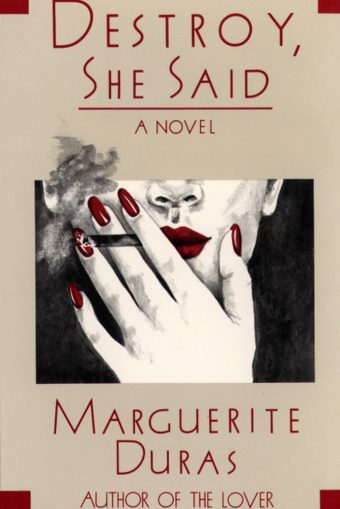 Marguerite Duras Destroy, She Said
Marguerite Duras Destroy, She Said
Grove Press
‘In this classic novel by the best-selling author of The Lover, erotic intrigue masks a chillingly deceptive form of madness. Elisabeth Alione is convalescing in a hotel in rural France when she meets two men and another woman. The sophisticated dalliance among the four serves to obscure an underlying violence, which, when the curtain of civilization is drawn aside, reveals in her fellow guests a very contemporary, perhaps even new, form of insanity.
‘Like many of Duras’s novels, Destroy, She Said owes much to cinema, displaying a skillful interplay of dialogue and description. There are recurring moods and motifs from the Duras repertoire: eroticism, lassitude, stifled desire, a beautiful woman, a mysterious forest, a desolate provincial hotel.
‘Included in this volume is an in-depth interview with Duras by Jacques Rivette and Jean Narboni.’ — Grove Press
______
Excerpt
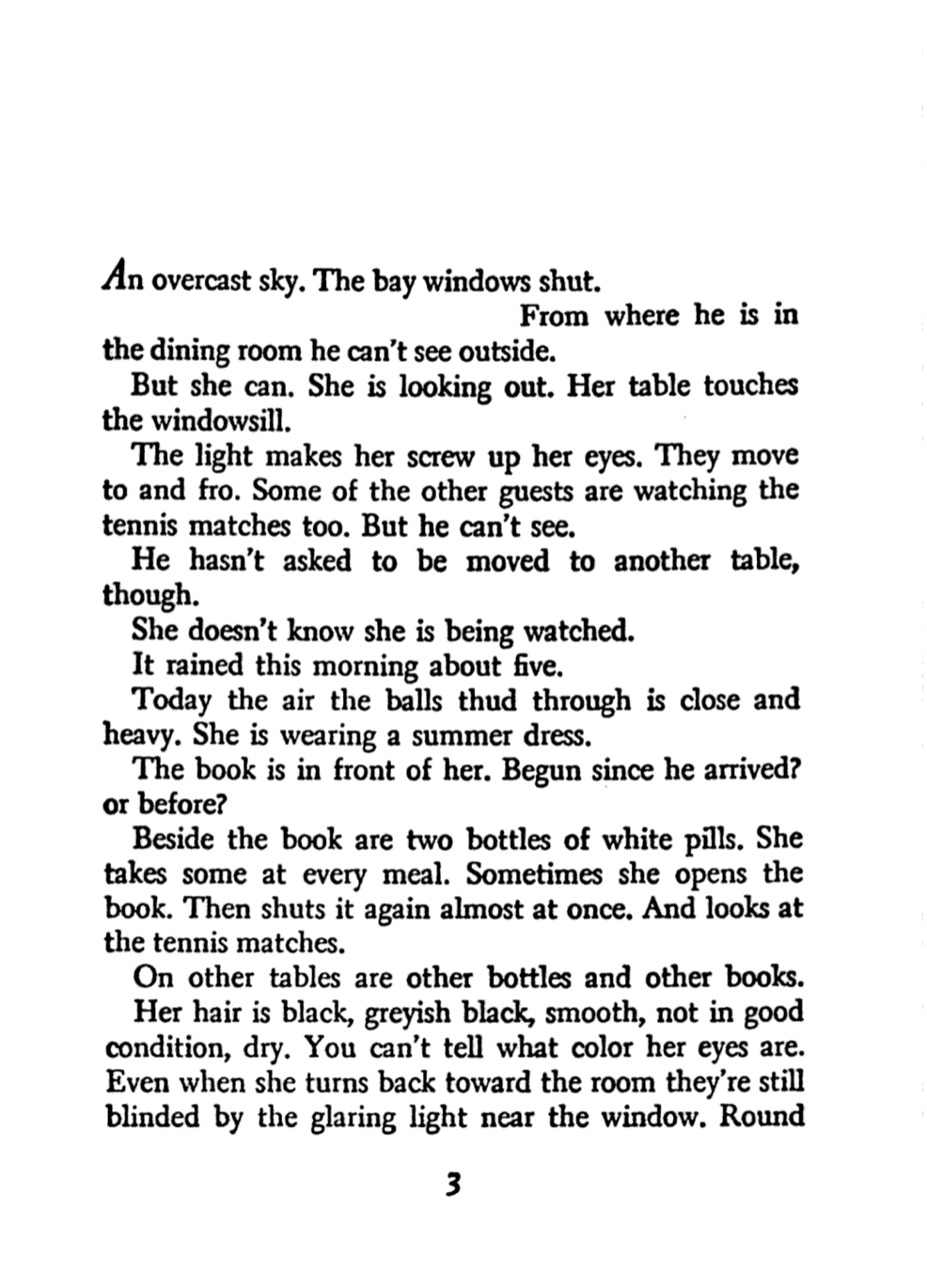
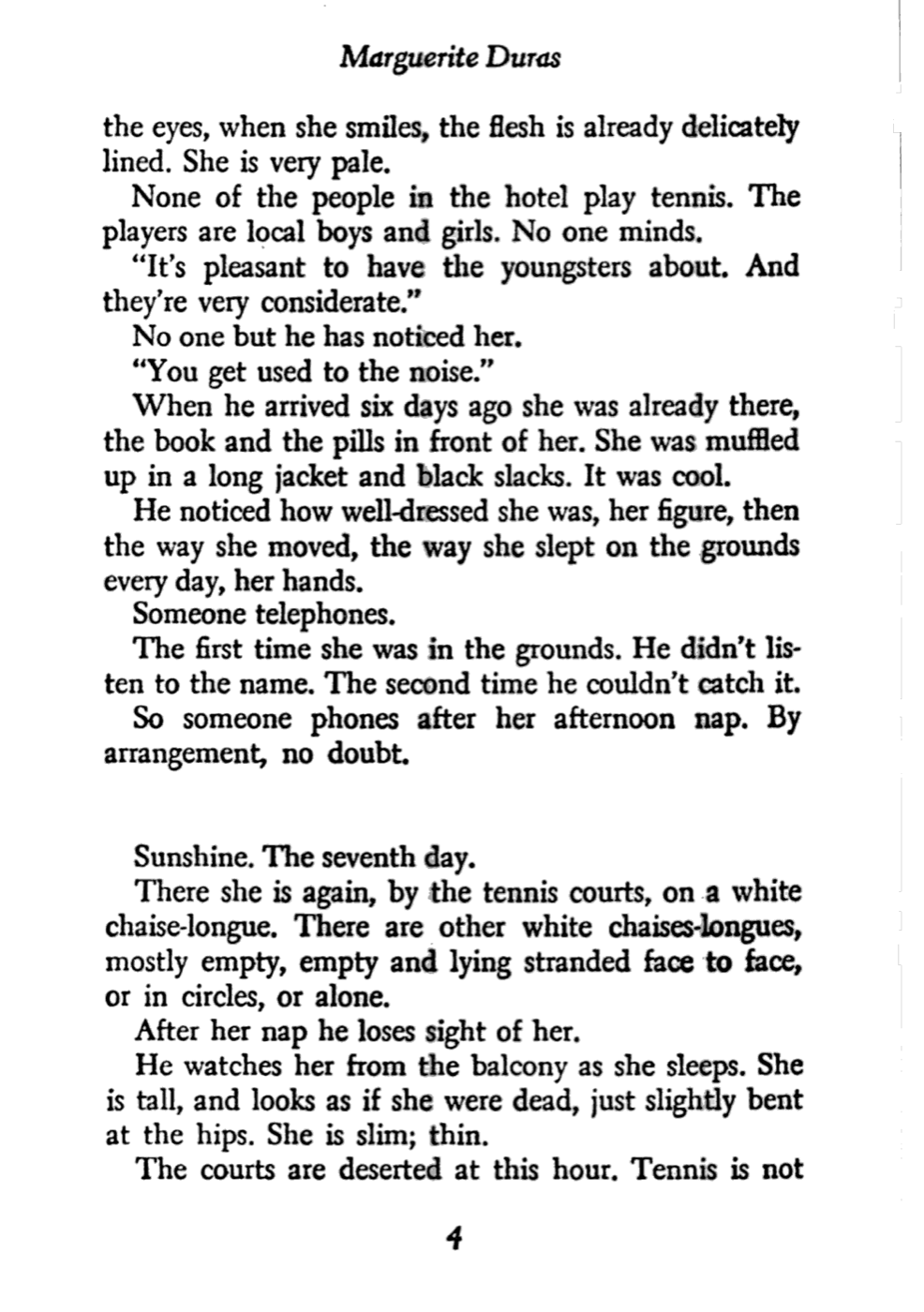

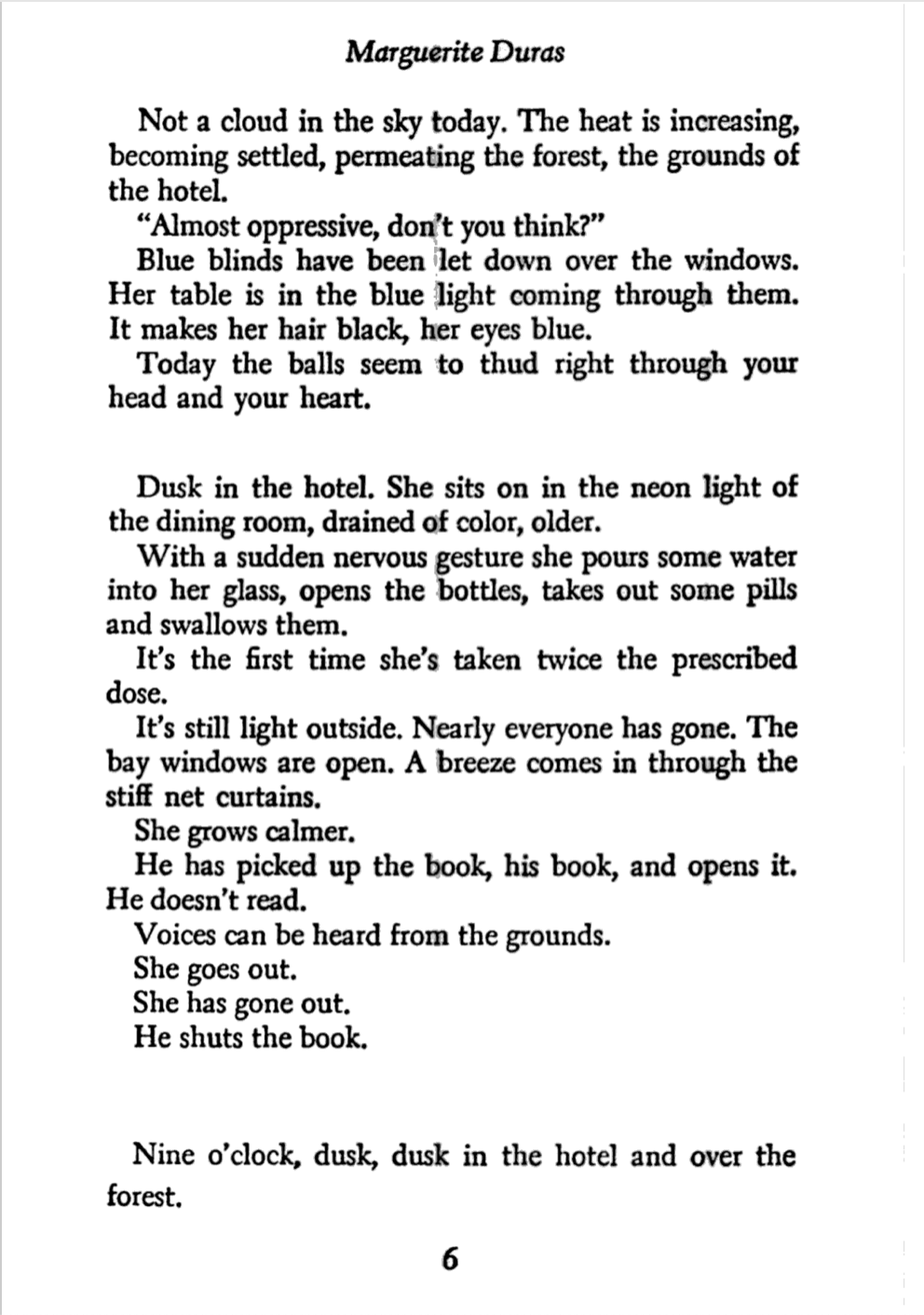
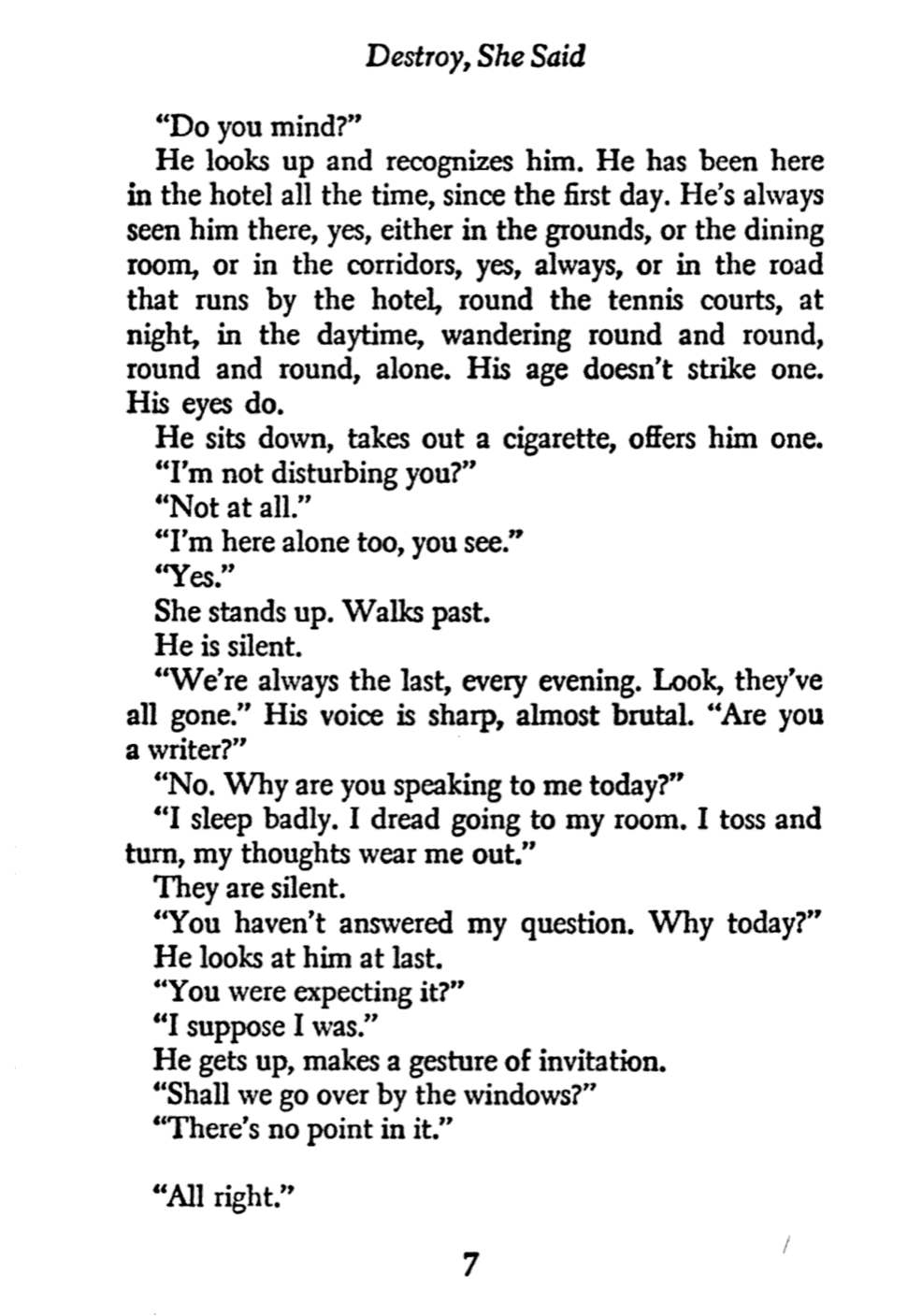
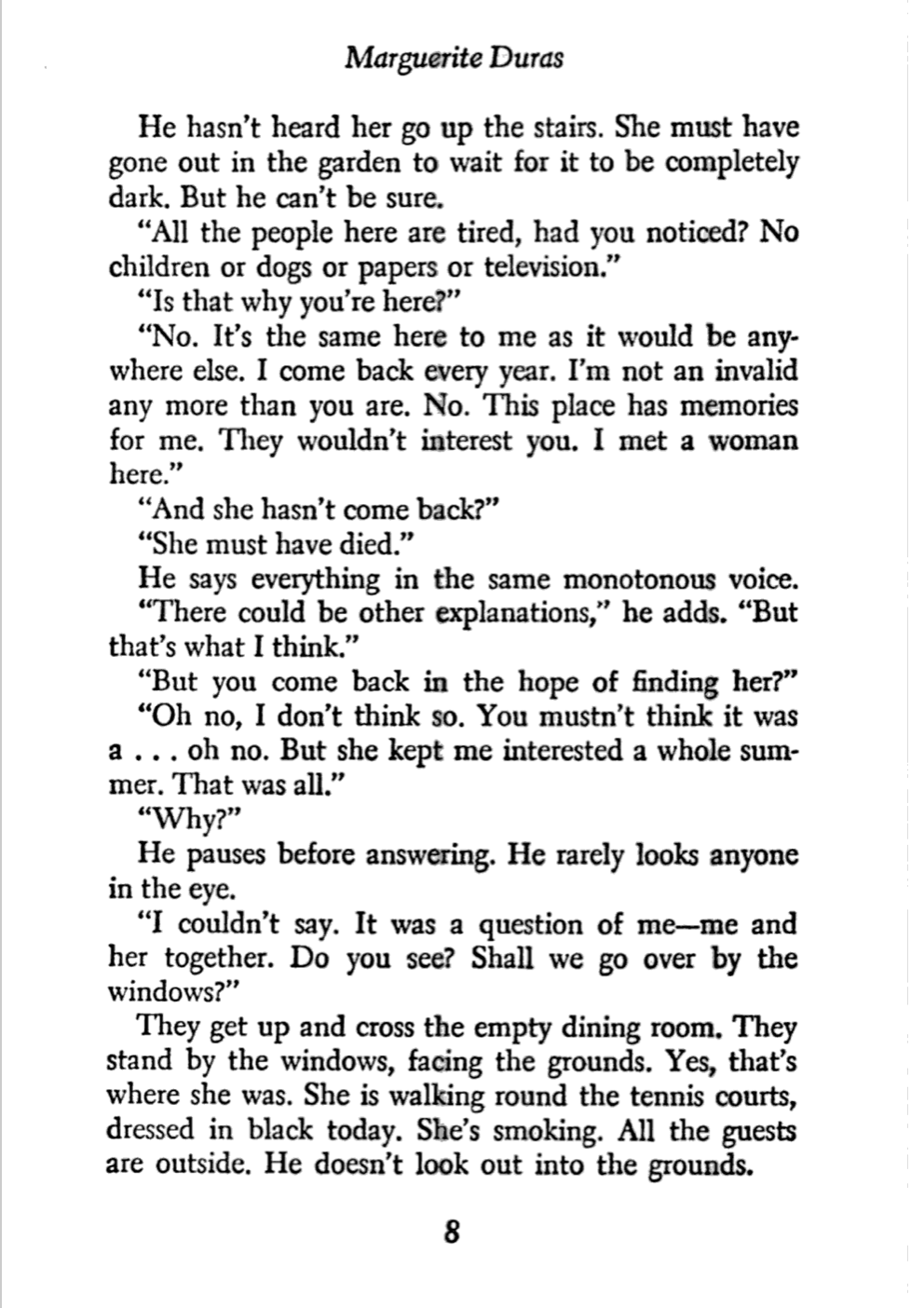
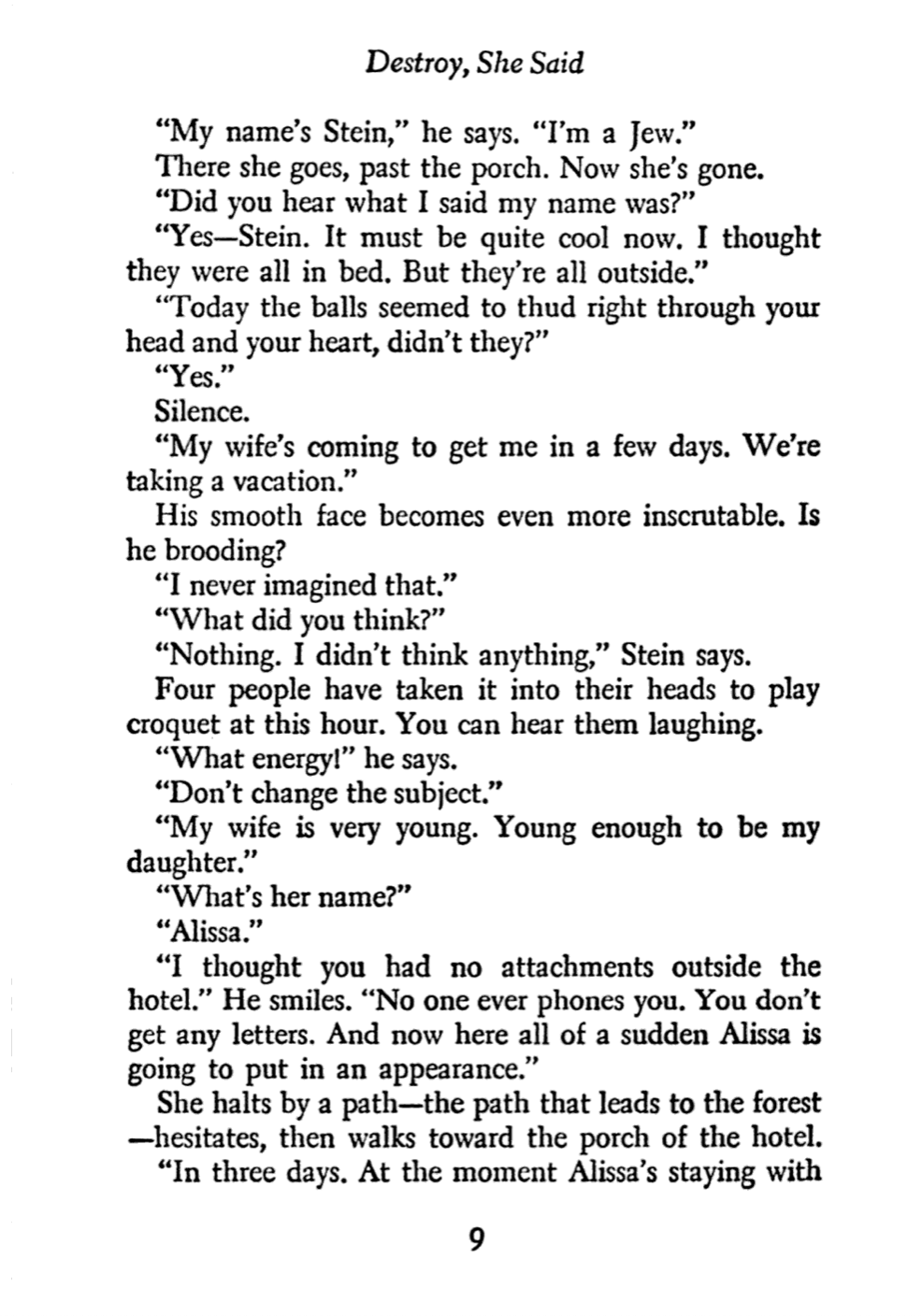
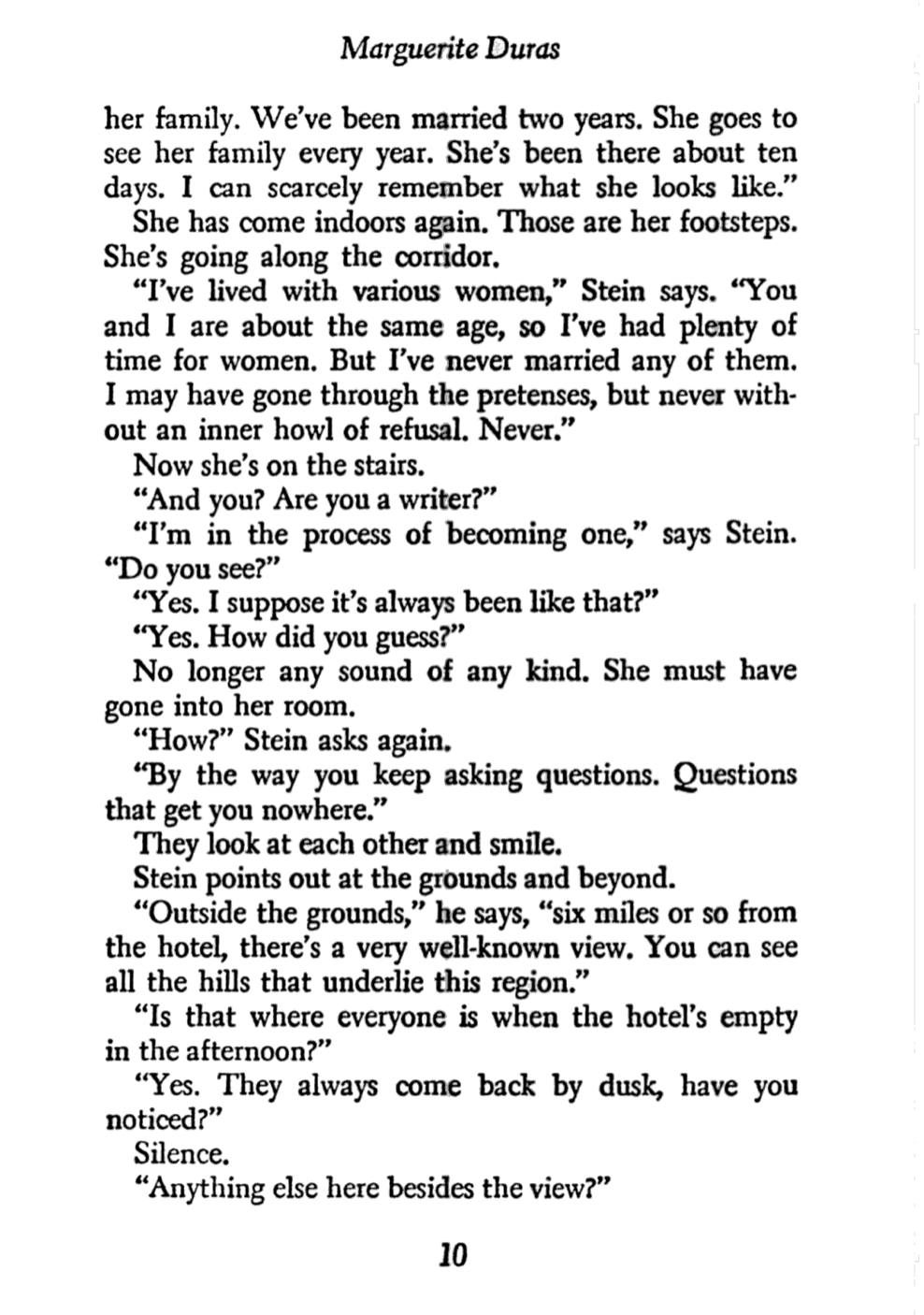
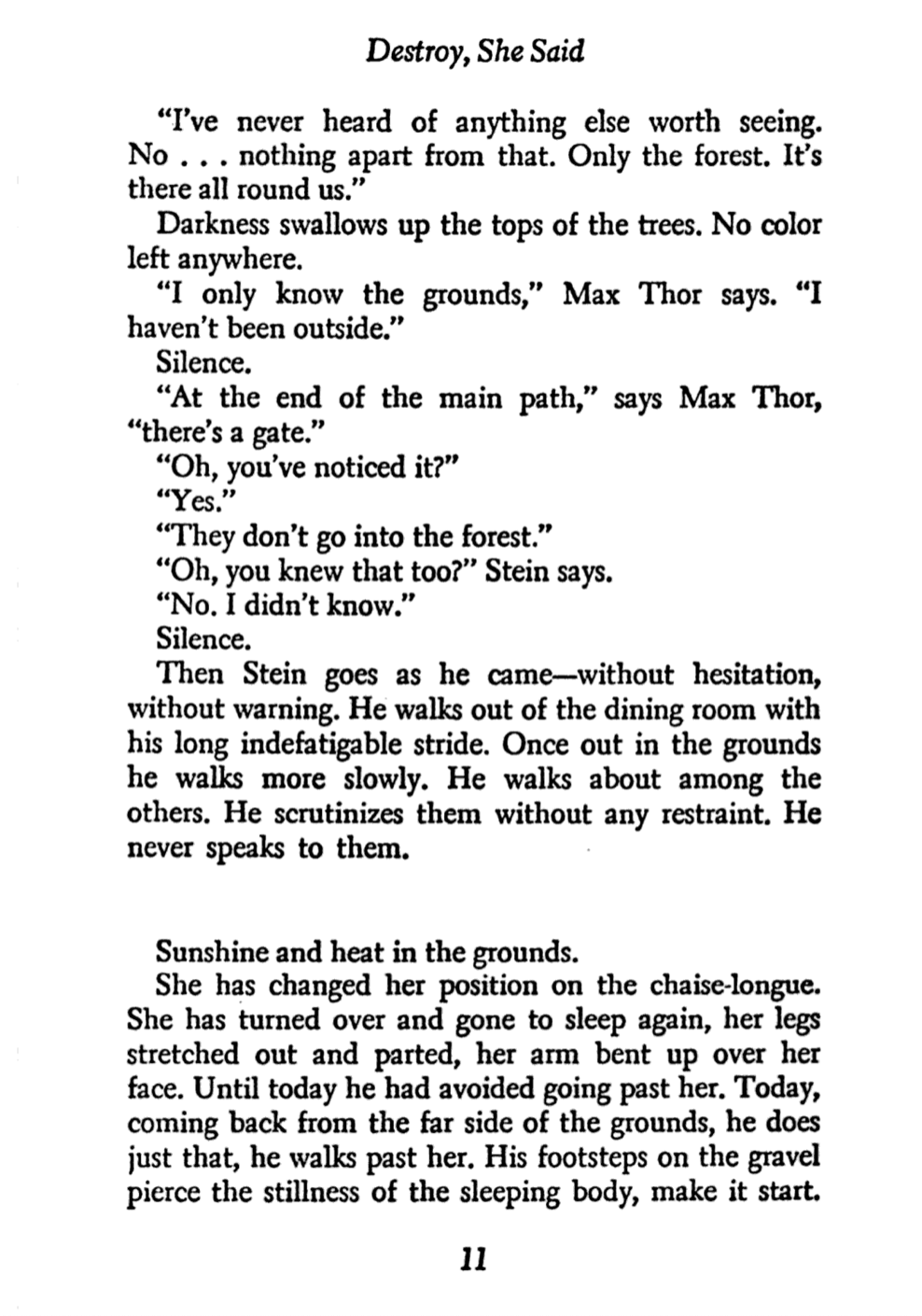
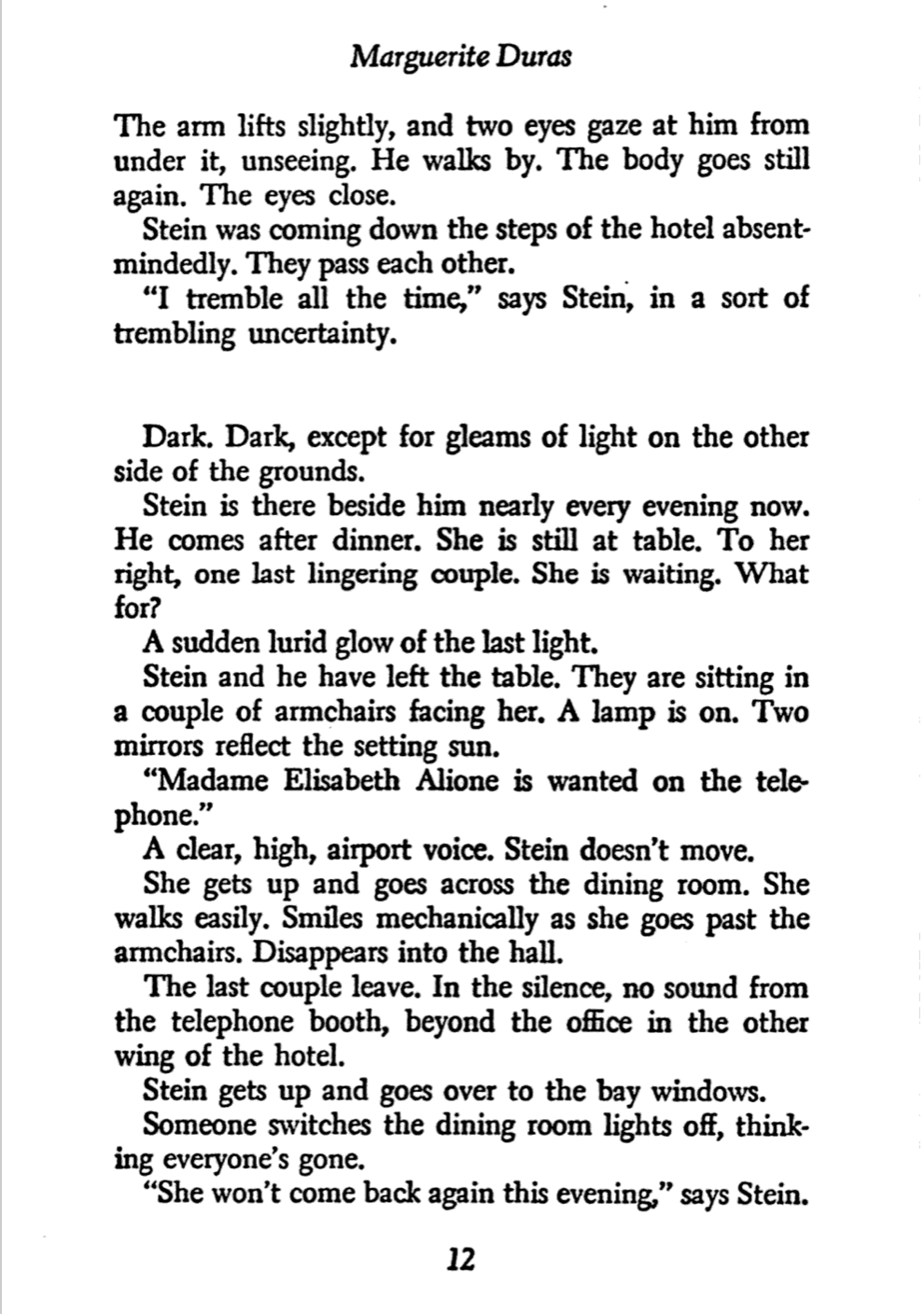
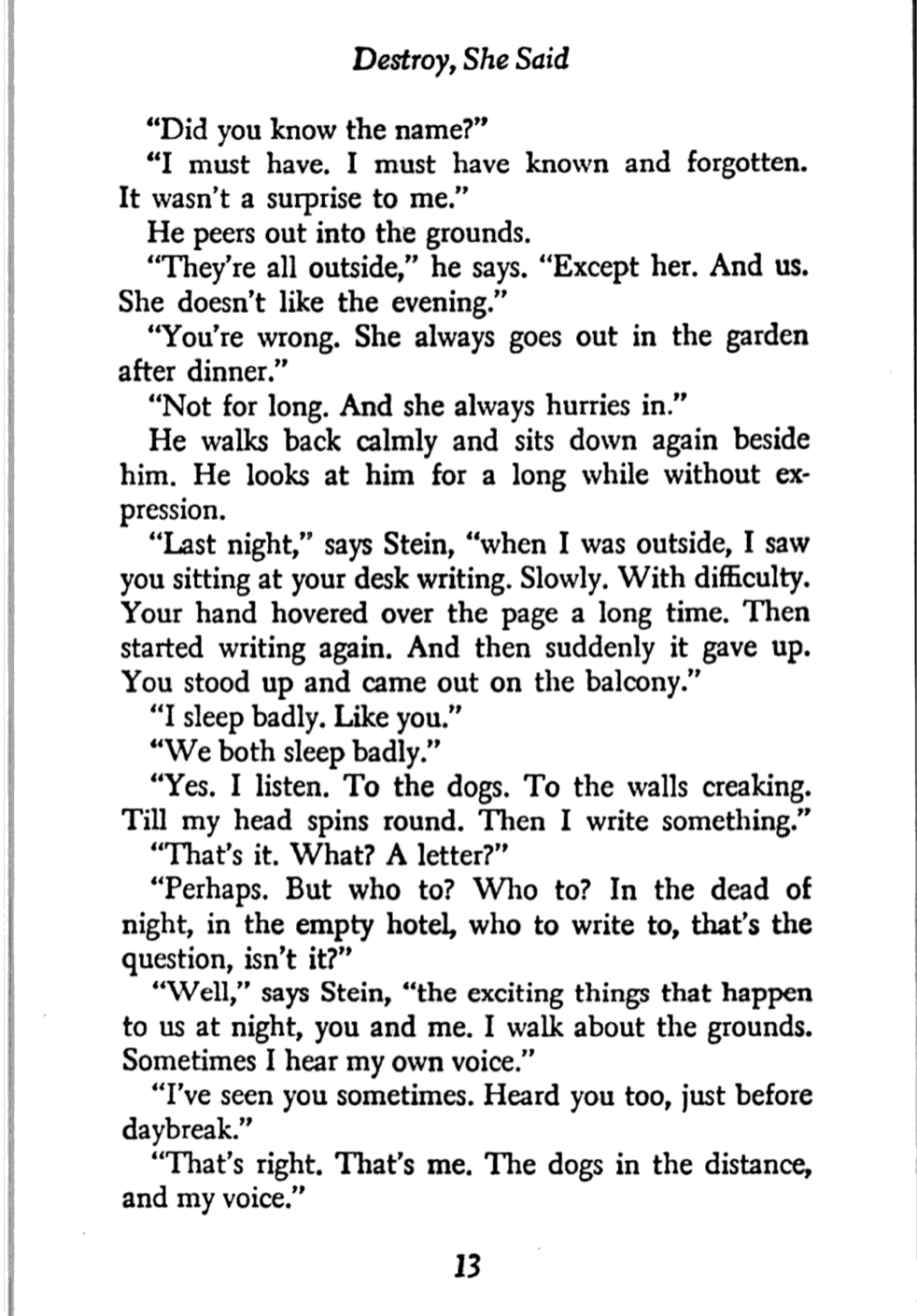
*
p.s. Hey. ** Dominik, Hi!!! Yes, he provided the descriptions. I think he wrote at least most of them, but there might be a few founds ones in there, I’m not entirely sure. The poster’s okay. It isn’t what we would have done, but we’re cool enough with it. It’ll probably start getting disseminated pretty soon, so you’ll see it. The festival was FESTIVAL DES CINÉMAS DIFFÉRENTS ET EXPÉRIMENTAUX DE PARIS. Here’s their site. Not sure when we’ll know about the Vienna festival. It’s a ways off, next May, so a bit of urgh about that, but, still, fingers very crossed. Me too, and my favorite pizza place is in LA, which is just as hopeless. Love practicing his pretend smile in the mirror, G. ** Jack Skelley, Jacko! It’s an excellent read. I do remember that Lena Lovich gig but not the opener. I’ve been trying for years to remember who Angelyne’s old band Baby Blue was the disastrous opening act for at the Whisky. Were you there? Could it have been Lovich? ** _Black_Acrylic, I do games, but I’ve never played any of those games yesterday. Yet. Not having yet indulged audio books, I can certainly make a case for print and ink style reading. ** Sypha, Me neither, but now I’m going to. I’m hoping your book stays in print long enough that I can refill by bank coffers and then immediately spring for it. Hopefully that book has opened the Champagne floodgates. ** Steeqhen, He’s been a dedicated gamer since he was 4, so, yeah. I’m going to start diving into his game collection asap. He told me Visage was the scariest of all to him, so I’m going to start there. I used to be a real album guy, but now I’m more a tracks guy, like everyone else basically. And I don’t even have Spotify as my excuse. Maybe it’s because I’ve never had a tiny shred of religious belief in me that I find conspiracy theories vaguely exotic at best. ** jay, So you have played some of them. None for me yet. Dude, so happy you found your footing. What an ignominious way to go if I’m using that term correctly. Still a waiting game on the festival, but what else is new. Walk with heavy footfalls today please. Tot siens! ** Carsten, If I were spiritually inclined, Tibetan Buddhism would be the first door I knocked on. Poet/filmmakers, let’s see … James Broughton, Lynne Sachs, Tarkovsky, Pagnol … I’d have to do a google to continue. ** Eric C., Hi, Eric! Cool, maybe I’ll do ‘Mouthwashing’ first. As I said up above, I’ve yet to play any of those games yet, silly me. I’ve been to some pretty good mall haunts, but I think all of them were just using dead mall spaces. Awesome about your neighbors. I shake their hands through time and space. You took your mom to see Swans, that’s wild. Cool mom, need I even say. I’ve seen Swans a few times live, but not in a very long time. I think the last time I saw them was in the 80s circa the ‘Children of God’ tour. Weird. ‘Still Wakes The Deep’: Gotcha. Thanks! ** Sarah, My friend’s son is a keeper, for sure. I’m okay. We’ll be touring the film for a while still. Tomorrow we go to Bavaria. It’s going really well, thank you. Wow, Kyler did a reading for you. I’ve never gotten one, but I’m rarely in that park, of course. He’s fun. Your project looks great! And the cancelled Muumuu House thing is very funny. Nice. I’ll go give it a long look and share it now. Everyone, Sarah has co-launched a really, really interesting looking publication that I strongly suggest you investigate. Here she is: ‘I thought I’d share this publication I’m a little involved in cause maybe you’d be interested, it’s a bunch of people but one of them is Nora Wright, who I guess you know. It’s called sentenced, I’ll post the link. Anyways, it’s fun to work on! We were saying we were Muu Muu House and we’re still saying Tao Lin is our editor in chief.’ Awesome! ** Alice, Hey, A. Visage is my son’s friend’s scariest of all pick. As I’ve said multiply, I’m a virgin to the grouping, though I hope to pop my cherry in that regard asap. Enjoy your current week! Totally into your thinking about distant friends. Meeting people (like yourself) after getting to know them ‘distantly’ on this blog is one of the truest pleasures. ** Nicholas., My friend is what they call a liberal parent. Trash is totally sculptable. Take it from me. And that does sound like a way forward, or the way forward, your choice. I’m my experience, the best fires have a little green in them. ** Steve, Yow, all the luck today. I’ve never had one, but I keep thinking there could be pleasure in it somehow? Brian Dennehy, could be worse. ** Hugo, He’s a very smart fella. I suspect he looked at the comments yesterday and saw your suggestion first hand. This blog is ideally very much about tonal whiplash, as best I can devise such a thing. Best back to you. ** darbz (¬ ´ཀ` )¬, No disappointment, perish the thought. Oddly structured things are the best! No, I haven’t read your thing yet, but I’m going to Germany tomorrow and I should be able to read it while there because I’m going to be what looks to be a very small town. See you too! ** HaRpEr //, Me too. That post was an eye opener on my end. David Ackles is great, and, yes, really bizarrely forgotten. I love ‘American Gothic’. ‘Montana Song’ is a favorite of mine. His album after ‘AG’, ‘Five & Dime’ has great stuff on it too. How noble of O’Rourke to support him. Don’t sweat the post-project worries. I thought I would be out of gas after my Cycle novels, but it didn’t work out that way. There’s always burning stuff. ** Connie, Hi, Connie! My only available Halloween plan is to go to the Halloween makeover of Parc Asterix. That and a Paris park that they’re spookifying for the season is all we’ve got over here. I really hope the film festival in Athens accepts ‘Room Temperature’ so I can see all of that for myself. Have big fun with it in the meantime. ** horatio, Hey! He’s a very cool guy, that boy. I still have this built-in belief that everyone has good intentions towards me, and I’ve been consequently fucked over a handful of times, but I’m still okay, so that belief hasn’t managed to die out. Yet. Cool about the Sotos book, Which one? Mm, I think ‘Safe’ is a little before I fully knew what I was doing, but I still really like the center section called ‘My Mark’. The rest seems a bit grasping to me. In my concept of your day today, everyone around you is charmed and highly respectful. And fun, if course. ** Bert, Hi, Bert. Oh, right, ‘Surrender Dorothy’, I still haven’t watched it but thank you for the nudge because now I’m writing the title in ink on a piece of paper that I will keep right in front of me. You’re going to Bainbridge screening. That’s great. Zac might actually be there for those screenings, maybe, we’re not totally sure yet. I think my favorite Burroughs is ‘The Wild Boys’. So maybe take a look at that? Nice to get to talk with you. Take care. ** Uday, No problem on the post idea fading out. I’d be happy to host if another exciting idea comes about. Writing nebulous prose, sure, of course. In that case I think I usually put it aside and wait until a weighty idea comes to me and then see if I can rob the nebulous writing for something I can use more productively. I just wait until I break out of it naturally. I always have. You can’t be nebulous for all that long, I don’t think. Patience, I guess? ** Okay. Today I’ve turned the spotlight back on one of my favorite Marguerite Duras novels in hopes that it will draw your attention. See you tomorrow.




 Now available in North America
Now available in North America 
Salut, you know the Death In June song ‘She Said Destroy’? David Tibet wrote the lyrics. Wonder if there is any connection to the book bar the title? Another one of life’s eternal mysteries. Haha. For what it’s worth I’ve never read the book. That’s my pithy comment for the day. X from Brussels. Ref : https://youtu.be/ATqkMqjDM_A?si=KQ_xcPJaCNspyfSW
It’s so true that the catalogue of Grove Press is eminently plunderable. I’m a definite fan of Duras but have yet to sample Destroy, She Said so thank you for this Spotlight! Have scheduled Charlotte Northall’s Practicing Dying as my next purchase of printed paper but this will be added to the soon-to-be-read list.
Speaking as a former painter… there’s a Gerhard Richter retrospective just opened at the Fondation Louis Vuitton in Paris that looks fairly unmissable. Just read a ***** review of this by Adrian Searle and it brings back memories of when I first arrived in Chicago on exchange back in 2002. There was a great show of GR’s work at the Art Institute that had a major effects on me. Should you ever happen upon this exhibition, I would be interested to know your thoughts.
DDD — it came back to me when Lovich was singing avant DEVO: Wazmo Nariz?! I think he wore a suit coat and TWO TIES! And had a song “Checking out the Check-out Girl.” Funny you mention Angelyne. I never saw her band, but she’s still banging around here… and even had art installation earlier this year: celebrities portraits composed entirely of food. She arrived in pink Corvette. luv ya! Jack
Hi!!
I’m very curious, after everything, about the poster.
Thank you for the link!!
May isn’t *that* far off! I so, so hope it’ll happen!
I feel love’s struggle on a deep, personal level. Love learning to draw overnight because he has so many images in his head, and he can’t draw for shit, Od.
Great title, & a character bent on “annihilation of ‘civilized’ egoism”: now we’re talking!
Whenever someone makes the argument that pagan animist ur-beliefs & the doctrinal aspects of what we call “organized religion” are irreconcilable I cite Tibetan Buddhism as the great counter-example.
So you’re off to Hof tomorrow? How long will you be staying? Any plans for the downtime between screenings?
I think my added comment yesterday fell through the cracks: Did you hear from your BlazeVox author friend?
Hi Dennis!
Playing hooky in order to do things like … read the new Pynchon and catch up on your blog! Much love from the Northwet. A brief summary of my happenings… Issue Seven of my zine is out, I’m working on a companion album of author’s reading their submissions with my “musical” backing, I’ve got a new collection of songs that I’m so happy with I’m not going to just put them on Bandcamp like the last dozen or albums, I’m trying to see if a little label will put it out on cassette so it can reach more people than I do…
Lots more too, but its all on the substack …
Take care! – L
Hello! Someone already mentioned the Death in June song, which is also what I immediately thought of when I saw the title. Knowing what the book is about sheds a bit of light on what the lyrics might be about. Do you prefer the film or the book? Also, how have you been? I was gone from the blog for a couple weeks because I was feeling too burnt out from school and social life, plus I was sick for a week with the flu and had some serious brain fog, but I’m feeling a lot better now.
What a beautiful book, from such a perfect writer. I’ve loved seeing this spotlighted again, Dennis. Thank you!
Love,
Thomas xoxo
The only pleasure might come from the anesthesia. I feel better on the other side of the colonoscopy, but now I’m completely exhausted. Having to wait 2 hours to see the doctor this morning was worse than the actual operation. I’m supposed to see him again in a few weeks for the results.
I haven’t read this Duras novel yet. Actually, I believe the only three I’ve read by her are THE MALADY OF DEATH, L’AMOUR, and THE LOVER.
Well, at the very least COMETH DARKNESS should eventually find a home because it’s still in the horror genre at the end of the day and there are a lot of horror publishers out there. PLEASANT TALES III is a bit more niche, I suppose. I just want to kind of get these unpublished manuscripts out there so I can devote my time to newer projects (like the basketball novel I started last month, provisionally entitled THE JOY OF THE WORM).
Hi. ‘Montana Song’ is indeed amazing. It’s strange how re-surgences end up happening. With Nick Drake I think he became a cult figure pretty quick and then years later that car advert brought him worldwide fame. I think Judee Sill is having one at the moment, or at least I happen to hear her name a lot.
I also wonder at what point in the future it will be when the Taylor Swift thing will die down. In thirty years or so will everyone just forget? Will she be touring stadiums when she’s approaching death’s door? Everything goes in cycles of course, but surely there was something that was the biggest thing on the planet fifty years ago which nobody remembers now?
I’ve been thinking about Duras a lot lately, especially ‘The Ravishing of Lol Stein’ since I’ve been really inspired by the framing device in that book, a watcher who is completely opaque and yet somehow opinionated. I haven’t read this one. I’ve been meaning to watch something that she’s directed as well.
I’m sure I’ve said this before but I always find it annoying how her most interesting books are the least re-printed/distributed and widely talked about in the US and UK.
That’s a good way to think about what happens to a project after it’s done. It’s never really over is it? Also, I guess there’s a difference between being haunted by and being obsessed by something.
I’m not worried about exhausting myself of ideas because I think I have different parts of my brain that I tap into when I write different things and I don’t exactly think I have just one thing or just one set of things that I’m interested in (I don’t even know how to casually explain what exactly it is that I’m interested in). Granted, I’m very pointedly trying to maximise every strength I have with this project and each book is going to be completely different.
Hey Dennis,
I’ve been using Spotify since 2014 (on and off between 2015-2018) that I hate how dependent I’ve become on it as my main way to listen to music. I assume that with the advent of AI the Spotify algorithm is a lot worse, though as I mentioned, I mostly listen to albums and ‘find’ music mostly through social media or friends, but back in the day the Spotify algorithm was incredible for finding music! I have been tempted to start downloading albums onto my phone, or using some sort of ipod/mp3 player, but the ability to just randomly listen to a new album or album i dont have downloaded would make me go straight back. Xiu Xiu removed most of their music from Spotify recently though, along with a few other artists, and I have been in the mood to listen to A Promise these past few days; a few years back when I was in hospital after getting my tonsils removed i would wake up in the middle of the night with pain, and I was so distraught from having a lot of interpersonal issues around that time that i was completely hollow inside, and I remember putting on their cover of Fast Car and subsequently the whole album one night and I now have this weird nostalgia associated with that album.
Anyway, do you just listen to music through like iTunes or CDs or some other way?
I’m somehow both deeply affected by religion and completely disconnected from it. I am completely fascinated in basically every faith and especially when they’re just cults or some strange belief. I think I’m fascinated in an outsider way but also have my own experience with growing up in a religion. Even now I can’t say that it was a big part of my life, because it wasn’t. But at the same time it was in every facet of my life, and I can’t say I grew up without it having any toll or effect on me. On the cult side, I found a copy of Dianetics in my local charity shop a few years back and bought it because I was so fascinated. I mean, I didn’t know that scient0l0gy (i dont know if they still stalk their name online) had made it to Ireland, nevermind my country-suburban area! And the fact that whoever owned it had ended up giving it into the charity shop… Some day I will read through it, though it’s a thick book, and from what I’ve skimmed through of it, an incoherent mess.
*Poof* Haha emerald is my birthstone so let’s say silver and emerald fire haha thats a sick furnace ember. God my mom hated video games and hated even more that I played them it was a drag forcing her to buy me games but it worked out in the end I was well supplied never had the heart>Stomach for horror games tho fun is always prime objective. And yes I do think thats right for me I don’t get left ima leaver and I’ve had the narrative soooo fucked up no more! Okay ill vlog tomorrow so you need to tell me how to make an arts schedule I took the time to create all the channels and I may have performance dysphoria where what I do is amazing I just lack an audience telling me it is so I move on with the same great effort just no follow through changing that I’m committing to it all I need my gay porn star star tattoos take about retro. TTYLXOXBRB
Good to see this day again, Dennis. I’ve read a few Duras novels, but years ago, don’t think I’ve read this one. I should definitely spend some time combing through her work again. I see a number of her books available for Kindle, which would be perfect for an upcoming trip.
Saw Cristian Ponce’s latest movie “A Mother’s Embrace”. It’s pretty fun but nowhere as good as “History of the Occult”. There’s a beautifully weathered crumbling old nursing home with disturbing characters staggering around in it, and good tentacles.
Bill